How the U.S. Abandoned Capitalism and What Took Its Place
Share
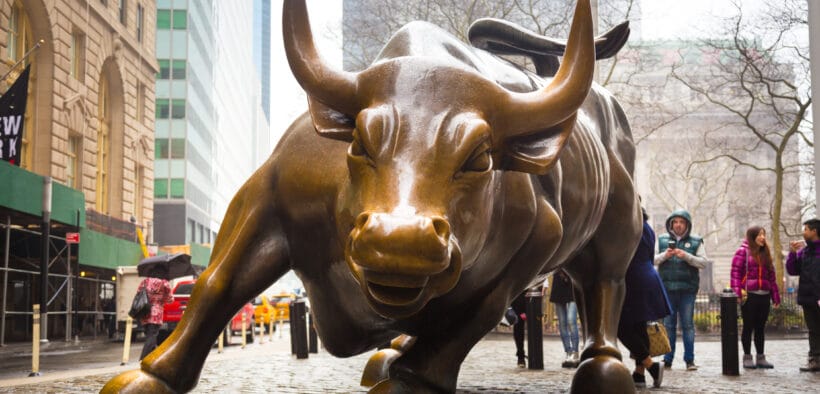
I bet you believe that capitalism is the economic system that describes the U.S. economy. I certainly did. I did, that is, until I discovered that I was wrong. Capitalism perished some years ago. Its fate was sealed on March 19, 1968. That’s when President Lyndon Johnson signed Public Law 90-269. By implementing this legislation, Congress did away with the requirement that the Federal Reserve back the U.S. dollar with gold reserves.

Back in 1968, the implications of moving past the gold standard almost certainly could not have been fully understood. However, delinking the dollar from gold unleashed revolutionary changes in fiscal and monetary policies. Ultimately, its most important outcome was the discovery of a radical new way to create economic growth, and propel the value of stocks, real estate, and other assets skyward.
Capitalism didn’t die immediately following the government’s abandonment of the gold standard. Eventually, however, central bankers, bureaucrats and politicians began to understand that they had come into possession of an almost magical ability to produce targeted economic outcomes. Once policymakers understood their new powers, capitalism’s days were numbered.
What system supplanted capitalism? Richard Duncan, a noted macroeconomist, has written extensively on this topic. Duncan’s term for the system that succeeded capitalism, the one we have today which is based upon fiat* money is creditism. (Fiat money is money solely because a government has decreed it to be so. It is not backed by a tangible asset such as gold.)
An author, lecturer, and publisher of the Macro Watch video newsletter, Duncan has shown that, unlike in the past when the economy grew as a result of businesspeople saving and investing, earning profits- capital– and reinvesting their capital, today it is annual increases in the total volume of credit that generates economic growth and keeps asset prices climbing. Duncan believes that this fact is the single most important thing to understand about today’s economy.
How Credit Growth Stimulates Economic Growth
When considering how credit growth stimulates economic growth, it’s important to know the answer to this question: On an annual basis, what amount must total credit grow by in order to keep the economy humming along? The answer is that total credit must grow by a minimum of 2%, adjusted for inflation. For example, imagine that inflation is 3%. This means that the entire credit pie must increase by 3% + 2%, or 5%. How do we know that this is true? We know it is because, since 1950, the U.S. has experienced nine recessions. Each recession was immediately preceded by a period of total credit growth that sunk below 2%, adjusted for inflation.
It’s hard to get one’s mind around a number as large as $85,000,000,000,000 ($85 trillion). However, that’s how incredibly large the credit pie has become. When the U.S. abandoned the gold standard, total credit stood at $1 trillion. Credit has multiplied 85-fold since. Knowing this, you might be thinking,
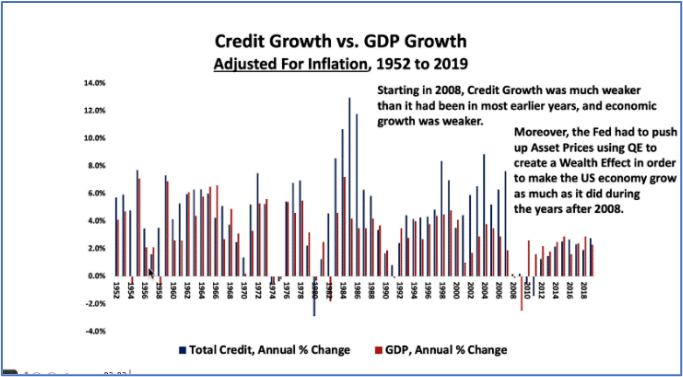
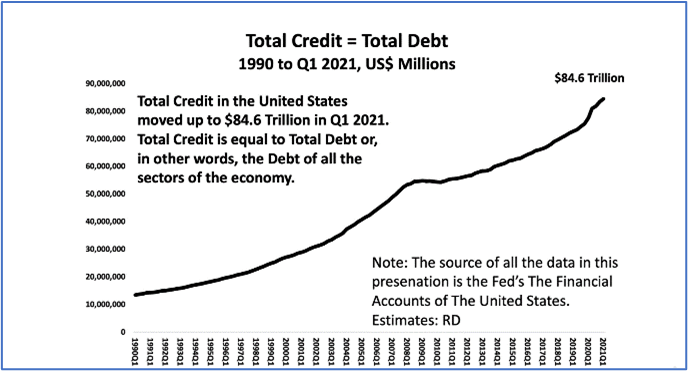
“Given the massive size of the credit pie, how is it even possible to produce increases in total credit that are significant enough to grow the economy ?” Recent experience shows that there has been only one way. Because the other sectors of the economy (households, corporate, state & local governments, GSEs, non-corporate business, financial) cannot possibly absorb the amount of new credit required to meet the credit growth threshold, it is only the federal government that has been able to make it achievable. From Q1 2020 thru Q2 2021, for example, the federal government accounted for 64% of the total increase in credit.
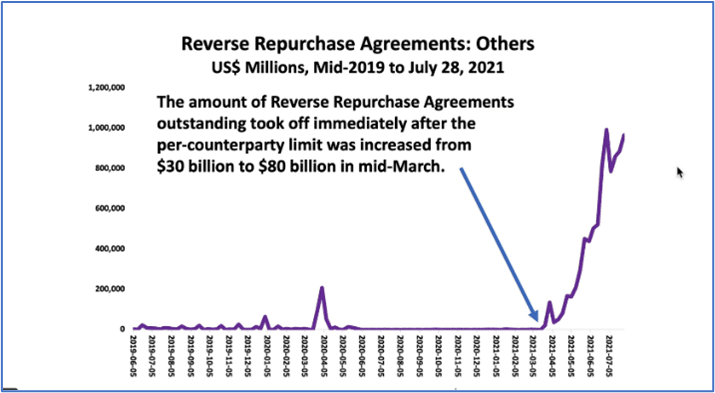
Recently, we’ve seen a breathless pace of credit growth, beyond anything in our history. Using the process of quantitative easing (QE), since August 2019, the Fed has created new credit equal to $4.5 trillion. Almost instantly, the Fed’s total assets ballooned by 119%.
Bank reserves went through the roof as a result of the Fed making deposits in commercial banks’ reserve accounts. This is how the Fed creates money. The resulting tsunami of additional liquidity caused asset prices to soar. Interestingly, Duncan believes that interest rates would have already collapsed into negative territory were it not for the Fed’s vastly increased use of Reverse Repo Agreements.
Does it Seem that Stocks Only Go Up?
Before I understood creditism, “Why do stocks only go up?” was a question I asked myself many times. I wondered about soaring stock prices because of all of the money that has been created. I’ve also wondered why in recent years we haven’t seen the emergence of high inflation or even hyperinflation? I believe creditism gives us the answers. When the real estate bubble burst in 2007, creditism enabled the Fed to create so much liquidity that we avoided falling into another Great Depression. Stock prices recovered quickly and, along with other assets, including real estate, values have since moved ever higher. As of Q2 of 2021, household net worth rose to an astonishing $142 trillion, double that of the pre-crisis high in 2007. Is it a coincidence that total credit doubled during the same period?
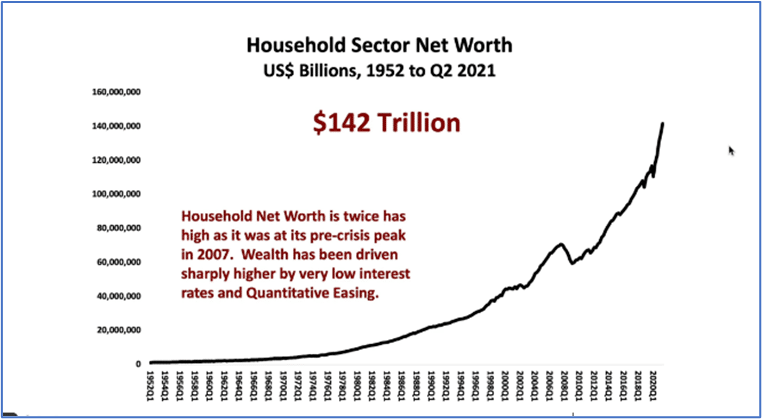
Will the good times keep rolling? Maybe not. Concerned that inflation has become more severe and potentially longer lasting than it had originally presumed, the Fed has told us that it will more quickly taper its monthly purchases of treasuries and mortgage-backed securities. The Fed now intends to end its asset purchase program by March 2022. Significantly, this shift will cause the rate of credit growth to slow considerably.
Moreover, the Fed has recently signaled that interest rates are likely to go up starting next year. In a recent video newsletter, Duncan stated, “If the markets begin to expect rate hikes, the Dollar could strengthen substantially, with negative consequences for gold, other commodities, world trade, economic growth and corporate profits.”
An Important Metric: The Wealth-to-Income Ratio
The wealth-to-income ratio is something you should keep an eye on. Thus far, creditism has caused asset prices, including stocks and real estate, to dependably increase to the point where prices have become extremely inflated. The inflated prices can be seen in an index the Fed publishes quarterly, Household Net Worth as a Percentage of Disposable Personal Income. For 50 years, the index moved within a range averaging 549. Just before the dot com bubble burst, the index had climbed to an all-time high of 615. By 2007, the index had soared once more, to another all-time high of 669. This was immediately before the real estate bubble burst. As of Q3, 2021, the index stands at 796!
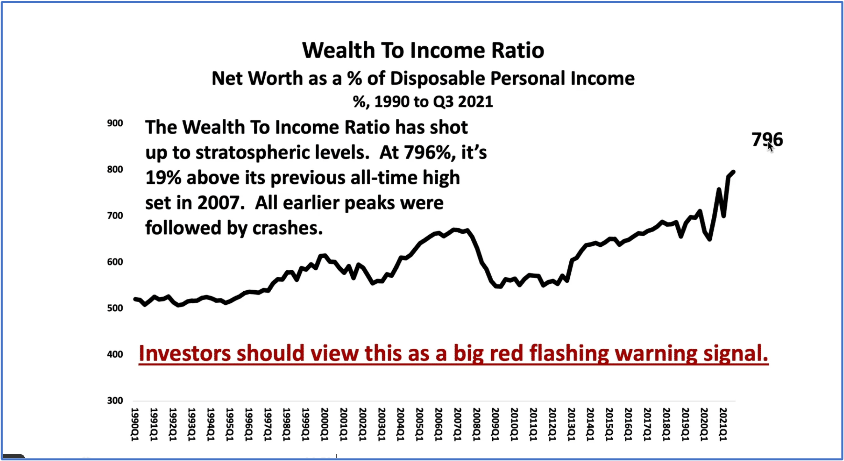
I believe that many investors may have come to expect that the Fed would continue to keep interest rates extraordinarily low. And many investors may have assumed that the Fed would continue to flood the financial markets with new liquidity. Now that it has become clear that Fed policy is changing, will this ignite a big selloff in stocks?
We should keep in mind that a great deal of borrowed money has been used for speculation. Could this cause a potential selloff to become even more severe? Another important question: Will higher interest rates strengthen the dollar? Considering that central banks in Europe and Japan have held their interest rates lower than the Fed has, an increased widening of spreads is likely to boost the dollar. Said Duncan, “A stronger dollar tends to be bad for the global economy, corporate profits, gold, commodity prices, and other asset prices.”
Recall that the last time the dollar rose, June 2014 thru March 2015, commodity prices plunged, world trade contracted, U.S. corporate profits fell, and stock prices stalled for a bit. It’s important to recall that during this period the Fed had ended QE. In response to the economic slowdown, the Fed resumed QE, pumping billions upon billions of new dollars into the system. In response, stock prices catapulted skyward. Once again, creditism saved the day. By the way, have you noticed that politicians have stopped talking about the size of our national debt?
Now, thirteen years past the last crisis, creditism has driven total credit up to $85 trillion. Is it possible to continue to produce increases in credit large enough to keep expanding the economy? As of November, the Consumer Price Index had increased 6.8% over the preceding 12 months. This is the largest increase in inflation in decades. Can the government increase total credit again by the amount needed, 6.8% + 2% = 8.8%?
In other words, is it possible to create enough money to expand the credit pie by an additional $7,480,000,000,000?
If you are an investor, and especially if you are a retired investor, it’s prudent to contemplate how you would answer these two questions:
Will creditism once again save the day?
Will it be different this time?
Author’s note: My thanks to Richard Duncan for allowing me to use several charts from his Macro Watch newsletter. Duncan has graciously offered a 50% discount to any reader who wishes to become a Macro Watch subscriber. I highly recommend this newsletter. If interested in a subscription, use discount code: Life
